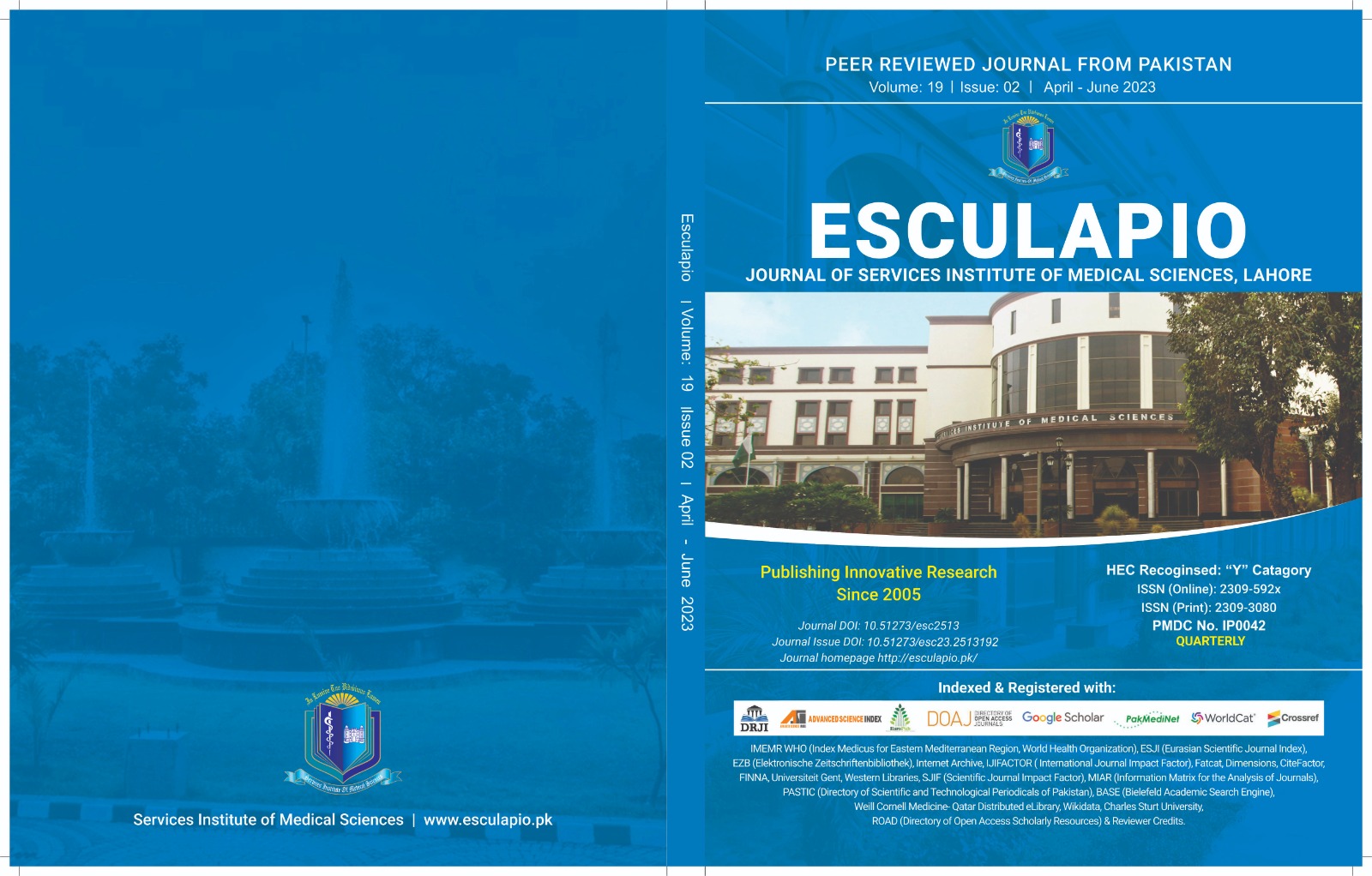Bacterial Isolates and their Antimicrobial Susceptibility Pattern from Tracheal Secretions and Sputum of Admitted and OutdoorPatients
DOI:
https://doi.org/10.51273/esc23.251923Keywords:
Antibiotic sensitivity pattern, gram negative rods, gram positive cocci, sputum specimens, tracheal secretionsAbstract
Objective: The purpose of study was to determine the frequent pathogens in tracheal secretions and sputum specimens along with the antimicrobial susceptibility pattern.
Methods: This descriptive study was conducted in the department of Pathology and Microbiology, Farooq Hospital Lahore, Pakistan and data included was taken from 1st August 2022 to 31st December 2022. The specimens were inoculated on blood agar and MacConkey agar and incubated for 24 hours at 37 0 C. The Kirby Bauer disc diffusion method was employed to find out the antimicrobial susceptibility pattern. The SPSS was used to assess the data.
Results: From the total 102 positive culture growths, Klebsiella species (35.2%) was frequently isolated followed by Pseudomonas species (25.4%), Acinetobacter species (23.5%), Escherichia coli (9.8%), Staphylococcus aureus(3.9%), Citrobacter species (0.9%), and Proteus species (0.9%). The doxycycline and linezolid were completely effective (100%) against the gram positive cocci. The Klebsiella species, Pseudomonas species, Acinetobacter species, and Escherichia coli, showed maximum sensitivity to tigecycline.
Conclusion: The most commonly isolated gram negative rod was Klebsiella species and tigecycline was found to be the most effective antibiotic against it. Multidrug resistance among respiratory pathogens is the major issue so it is necessary to administer antibiotic therapy in a limited and objective manner
References
Ahmad H, Sadiq A, Bhatti HW, Bhatti AA, Tameez-Ud-Din A, Ibrahim A, Chaudhary NA. Bacteriological Profile and Antibiogram of Cultures Isolated from Tracheal Secretions. Cureus. 2019 Jun;11(6):e4965.
Shoar S, Musher DM. Etiology of community-acquired pneumonia in adults: a systematic review. Pneumonia. 2020 Oct;12(1):11.
Kim B-G, Kang M, Lim J, Lee J, Kang D, Kim M, et al. Comprehensive risk assessment for hospital-acquired pneumonia: sociodemographic, clinical, and hospital environmental factors associated with the incidence of hospital-acquired pneumonia. BMC Pulmonary Medicine. 2022 Jan;22(1):21.
Fiel S. Guidelines and critical pathways for severe hospital-acquired pneumonia. Chest. 2001 Feb;119(2):412S-8S.
Papazian L, Klompas M, Luyt CE. Ventilator-associated pneumonia in adults: a narrative review. Intensive Care Medicine. 2020 May; 46(5):888-906.
Torres A, Niederman MS, Chastre J, Ewig S, Fernandez-Vandellos P, Hanberger H, et al. International ERS/ESICM/ESCMID/ALAT guidelines for the management of hospital-acquired pneumonia and ventilator-associated pneumonia: guidelines for the management of hospital-acquired pneumonia (HAP)/ventilator-associated pneumonia (VAP) of the European Respiratory Society (ERS), European Society of Intensive Care Medicine (ESICM), European Society of Clinical Microbiology and Infectious Diseases (ESCMID) and Asociación Latinoamericana del Tórax (ALAT). European Respiratory Journal. 2017 Sept;50(3):1700582.
Bonell A, Azarrafiy R, Huong VTL, Viet TL, Phu VD, Dat VQ, et al. A systematic review and meta-analysis of ventilator-associated pneumonia in adults in Asia: an analysis of national income level on incidence and etiology. Clinical Infectious Diseases. 2019 Jan;68(3):511-8.
Siddique SG, Bhalchandra MH, Wyawahare AS, Bansal VP, Mishra JK, Naik S. Prevalence of MRSA, ESBL and Carbapenemase producing isolates obtained from endotracheal and tracheal tubes secretions of ICU patient at tertiary care centre. International Journal of Current Microbiology and Appled Sciences. 2017 Apr;6(4):288-99.
Gude SS, Venu Gopal S, Marasandra Ramesh H, Vuppalapati S, Peddi NC, Gude SS. Unraveling the Nature of Antibiotics: Is It a Cure or a New Hurdle to the Patient Treatment? Cureus. 2022 Apr 8;14(4):e23955.
Wu D, Wu C, Zhang S, Zhong Y. Risk Factors of Ventilator-Associated Pneumonia in Critically III Patients. Frontiers in Pharmacology. 2019 May;10.
Dray S, Coiffard B, Persico N, Papazian L, Hraiech S. Are tracheal surveillance cultures useful in the intensive care unit? Annals of Translational Medicine. 2018 Nov;6 (21): 421.
Tille P. Bailey & Scott's diagnostic microbiology-E-Book: Elsevier Health Sciences; 2015.
CLSI. Performance Standards for Antimicrobial Susceptibility Testing. 33rd ed. CLSI supplement M100. Clinical and Laboratory Standards Institute; 2023.
Kumarasamy KK, Toleman MA, Walsh TR, Bagaria J, Butt F, Balakrishnan R, et al. Emergence of a new antibiotic resistance mechanism in India, Pakistan, and the UK: a molecular, biological, and epidemiological study. The Lancet infectious diseases. 2010 Sept;10(9):597-602.
Pattanayak C, Patanaik SK, Datta PP, Panda P. A study on antibiotic sensitivity pattern of bacterial isolates in the intensive care unit of a tertiary care hospital in Eastern India. International Journal of Basic & Clinical Pharmacology. 2017 Jan ;2(2):153-9.
Gupta P, Gupta S, Singh JB. Bacteriological profile and the antibiotic susceptibility pattern of endotracheal secretions in ICU of a tertiary care hospital. Journal of Evolution of Medical and Dental Sciences. 2018 Apr;7(18):2210-4.
Chandra D, Laghawe A, Sadawarte K, Prabhu T. Microbiological profile and antimicrobial sensitivity pattern of endotracheal tube aspirates of patients in ICU of a tertiary care hospital in Bhopal, India. International Journal of Current Microbiology and Applied Sciences. 2017 Mar;6(3):891-5.
Malik M, Malik MI, Sajjad A. Pattern of bacterial pathogens isolated from endotracheal secretions in Intensive care unit (ICU) patients of a tertiary care hospital of Lahore. Pakistan Journal of Pathology. 2018 May;29(2):46-8.
George P, Sequiera A. Antimicrobial sensitivity pattern among organisms which were isolated from the endotracheal aspirates of patients with ventilator associated pneumonia. Journal of Clinical and Diagnostic Research. 2010 Jan;4:3397-401.
Malik MI, Malik M, Chaudhary A. Antimicrobial susceptibility pattern of bacteria isolated from tracheal secretions in intensive care units admitted patients of Lahore General Hospital. Pakistan Journal of Chest Medicine. 2018 May;24(2):72-7.
Althaqafi A, Yaseen M, Farahat F, et al. Risk Factors for Infection With Multidrug-Resistant Gram-Negative Bacteria in a Tertiary Care Hospital in Saudi Arabia: A Case-Control Study. Cureus. 2023, Apr 08, 15(4): e37291.










